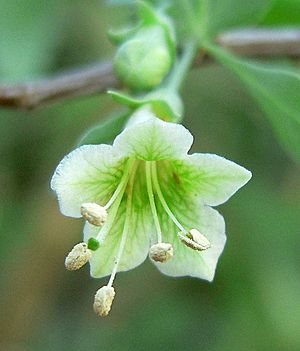Pale wolfberry facts for kids
Quick facts for kids Pale wolfberry |
|
|---|---|
 |
|
| Conservation status | |
| Scientific classification | |
| Genus: |
Lycium
|
| Species: |
pallidum
|
Lycium pallidum, also known as the pale wolfberry or pale desert-thorn, is a cool flowering plant found in the nightshade family. It grows naturally in northern Mexico and the southwestern United States. You can find it in states like Sonora and Chihuahua in Mexico, and from California to Texas and even up to Utah and Colorado in the U.S.
What Does Pale Wolfberry Look Like?
This plant is a shrub, which means it's a woody plant smaller than a tree. It usually grows about 1 to 3 meters (3 to 10 feet) tall. The pale wolfberry has many spiny branches that spread out or stand upright. These branches can grow so close together that they form thick, bushy areas called thickets.
The leaves of this plant are a light, pale color, which is how it got its name. Its flowers are shaped like a funnel and can be creamy-yellow, yellowish-green, or even a greenish cream color, sometimes with a touch of purple. They often smell nice and are pollinated by insects, which means insects help them make seeds.
After the flowers, the plant produces a juicy, shiny red berry. These berries are oval-shaped and can hold up to 50 tiny seeds! The pale wolfberry mainly grows new plants from these seeds. But it can also spread in other ways, like from cuttings (pieces of the plant that grow roots), or by sending out new shoots from its base (called suckering) or from branches that touch the ground (called layering).
Where Does Pale Wolfberry Grow?
The pale wolfberry is a tough plant that can live in many different kinds of desert areas. You might find it in pinyon-juniper woodlands, areas with lots of sagebrush, or open grasslands called savannas. It can even grow in soil that has a lot of salt!
This plant is very common in the Mojave Desert, and it also lives in the Sonoran and Chihuahuan Deserts. In the Mojave Desert, it often grows next to other desert plants like winterfat, Pima rhatany, and different kinds of ephedra, prickly pear cacti, and yucca plants.
In Arizona, the pale wolfberry can be found near rivers in areas called riparian habitats. Here, it grows alongside trees like sycamore, willows, Arizona walnut, and Fremont cottonwood.
Long ago, the Anasazi people lived in these areas, and the pale wolfberry is often found near their old ruins. It's possible they gathered the berries and dropped the seeds, or maybe they even grew the plants on purpose!
Many animals enjoy eating the fruits of the pale wolfberry. Birds called Phainopepla especially love them. Woodrats also like to munch on the plant's leaves.
How People Use Pale Wolfberry
Native American people have used the pale wolfberry for many different things, including medicine and food. The Navajo used it to help with toothaches. They also thought it was a very special, sacred plant and would offer it to their gods.
Several groups of people ate the fruit in different ways. They would eat the berries fresh, cook them, or dry them. Sometimes, they even mixed the berries with clay! People also boiled the berries to make a sweet syrup or turned them into drinks.
The Zuni people would eat the berries raw when they were perfectly ripe, or they would boil them, sometimes adding something sweet. They also used the ground-up leaves, twigs, and flowers, giving them to warriors for protection during battles.


